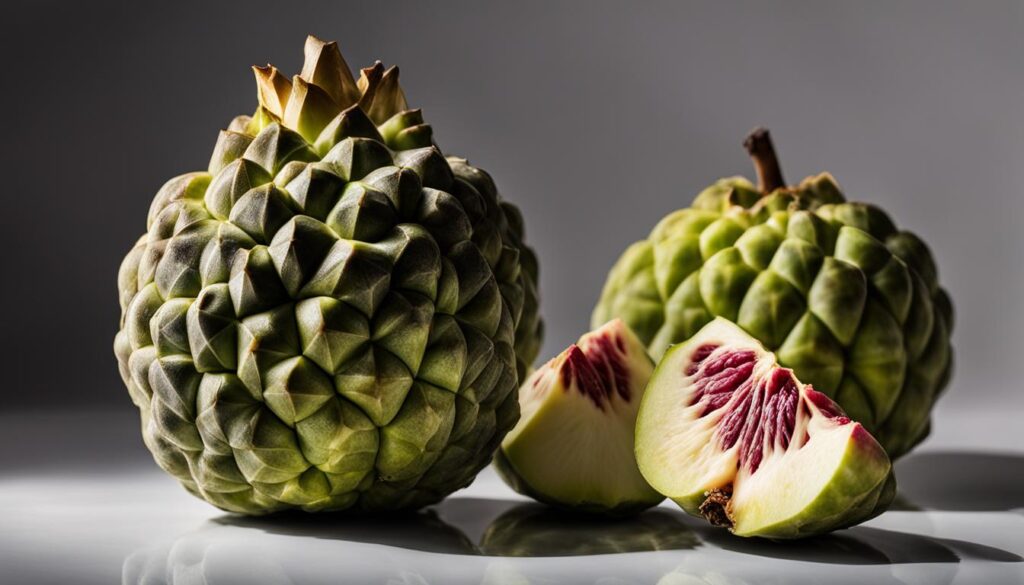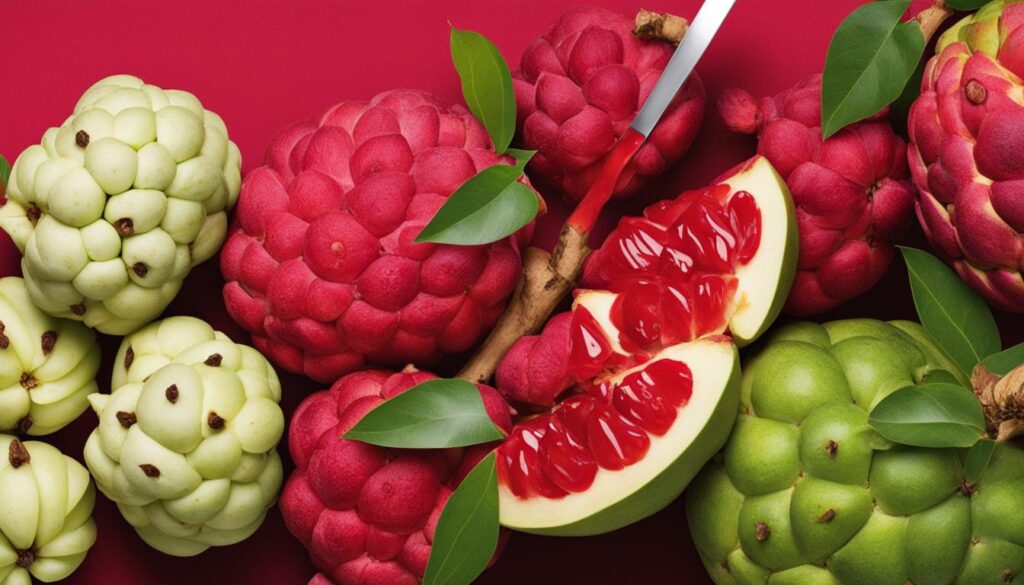Physical Address
304 North Cardinal St.
Dorchester Center, MA 02124
Physical Address
304 North Cardinal St.
Dorchester Center, MA 02124

Are you curious about the distinction between custard apple and sugar apple? These two fruits may seem similar, but they have unique characteristics that set them apart. In this article, I will delve into the comparison between custard apple and sugar apple, highlighting their dissimilarities and helping you understand their individual attributes.
The taxonomy and origins of sugar apple and custard apple provide interesting insights into these tropical fruits. Both fruits belong to the Annonaceae family, which includes other delicious fruits like cherimoya. The scientific name for sugar apple is Annona squamosa, while custard apple is known as Annona reticulata. These fruits are native to Central and South America, where they have been cultivated for centuries.
Table: Taxonomy and Origins of Sugar Apple and Custard Apple
| Fruit | Scientific Name | Native Regions |
|---|---|---|
| Sugar Apple | Annona squamosa | Central and South America |
| Custard Apple | Annona reticulata | Central and South America |
Both sugar apple and custard apple have spread to other tropical regions around the world due to their popularity and adaptability. Today, you can find these fruits in countries such as India, Thailand, the Philippines, and various islands in the Caribbean. They thrive in warm climates with well-drained soil, making them a staple in tropical agriculture.

| Sugar Apple | Custard Apple | |
|---|---|---|
| Taste | Sweet with slight acidity | Sweet and slightly chewy with hints of mango and banana |
| Texture | Grainy and custardy (varies among cultivars) | Soft and custardy |
| Aroma | Tropical and inviting | Fragrant and reminiscent of tropical paradise |
As you can see from the table, the taste differences between sugar apple and custard apple are evident. Each fruit offers a unique sensory experience, allowing you to explore the diverse flavors and textures of these tropical delights.
When it comes to culinary uses, both sugar apple and custard apple offer a range of delicious possibilities. These tropical fruits can be enjoyed fresh on their own for a sweet and refreshing snack. However, they also lend themselves well to a variety of recipes, adding a unique flavor and texture to dishes.
Sugar apple is often used in desserts, particularly in custards, pies, and ice creams. Its creamy and slightly tangy taste pairs well with creamy and rich desserts, creating a delightful balance of flavors. One popular recipe is a sugar apple custard, where the pulp of the fruit is blended with eggs, milk, and sugar, then baked until set.
Custard apple, on the other hand, is a versatile fruit that can be used in a wide range of sweet treats. Its soft and custardy texture is perfect for milkshakes, smoothies, and even sorbets. One simple and delicious recipe is a custard apple smoothie, where the fruit is blended with yogurt, honey, and a splash of milk to create a creamy and refreshing drink.
| Culinary Uses | Sugar Apple | Custard Apple |
|---|---|---|
| 1. Desserts | Pies, custards, ice creams | Milkshakes, smoothies, sorbets |
| 2. Fresh Consumption | Snacking | Snacking |
| 3. Substitutes | Can be used as a substitute for custard apple in recipes | Can be used as a substitute for sugar apple in recipes |
If you find yourself without one of these fruits, don’t worry! They can be used as substitutes for each other in recipes to achieve a similar flavor and texture. Whether you’re baking a pie or blending a smoothie, both sugar apple and custard apple offer a tropical twist to your culinary creations.
When it comes to nutrition, both sugar apple and custard apple offer a range of essential vitamins, minerals, and fiber. These fruits are not only delicious but also provide a healthy dose of nutrients for your body.
Sugar apple is a good source of vitamin C, which is known for its immune-boosting properties and antioxidant benefits. It also contains dietary fiber, which aids in digestion and helps maintain a healthy weight. Additionally, sugar apple is low in calories and carbohydrates, making it a great choice for those watching their calorie intake or managing their blood sugar levels.
Custard apple, on the other hand, is rich in potassium, an essential mineral that helps regulate blood pressure and maintain proper heart function. It also contains vitamin A, which is important for healthy vision and immune system support. Like sugar apple, custard apple is low in calories and high in fiber, making it a nutritious addition to your diet.
| Sugar Apple | Custard Apple | |
|---|---|---|
| Vitamin C | High | Low |
| Vitamin A | Low | High |
| Potassium | Low | High |
| Calories | Low | Low |
| Carbohydrates | Low | Low |
It’s important to note that the specific nutrition profile of each fruit may vary slightly depending on factors such as ripeness and growing conditions. However, both sugar apple and custard apple offer a range of health benefits and can be enjoyed as part of a balanced diet.
So whether you prefer the tangy sweetness of sugar apple or the creamy texture of custard apple, you can reap the nutritional rewards of these tropical fruits.

When it comes to growing custard apples and sugar apples, they both thrive in similar conditions. These tropical fruits prefer warm temperatures and well-drained soil, making them ideal for cultivation in tropical regions. Whether you’re growing them in your backyard or on a larger scale, providing the right growing conditions is crucial for a successful harvest.
Pollination is an important aspect of fruit production, and both custard apples and sugar apples require pollination from insects or manual intervention. Bees and other pollinators play a vital role in transferring pollen from the male to the female flowers, ensuring the development of fruit. If pollinators are scarce in your area, you may need to hand-pollinate the flowers to ensure a good fruit set.
Harvesting the fruits at the right time is essential to enjoy their delicious flavors. Sugar apples are typically harvested when they have reached their full size and the skin color has changed from green to a vibrant purple or yellow. Similarly, custard apples are ready to be harvested when their skin color turns from green to a reddish-brown, and the fruit comes off the tree easily when gently twisted.
After harvesting, both custard apples and sugar apples should be stored at room temperature to allow them to ripen further. This process usually takes a few days, depending on the fruit’s maturity at harvest. Once they have ripened, the fruits can be consumed immediately or stored in the refrigerator for a few days to prolong their shelf life.
| Aspect | Custard Apple | Sugar Apple |
|---|---|---|
| Growing Conditions | Tropical regions with warm temperatures and well-drained soil | Tropical regions with warm temperatures and well-drained soil |
| Pollination | Insects or manual intervention | Insects or manual intervention |
| Harvest | When skin color turns from green to reddish-brown and fruit comes off the tree easily when gently twisted | When size is full and skin color changes to vibrant purple or yellow |
| Storage | Room temperature until fully ripened, then refrigerated for a few days | Room temperature until fully ripened, then refrigerated for a few days |
After comparing custard apple and sugar apple, it is clear that these two fruits have distinct characteristics that set them apart. While they belong to the same plant family and share some similarities, such as their creamy white flesh and sweet flavor, their differences in appearance, taste, and culinary uses make them unique.
Sugar apple, with its bumpy green or purple skin and grainy texture, offers a sweet flavor with hints of acidity. It is commonly used in desserts and ice creams, adding a delightful tropical touch. On the other hand, custard apple boasts smooth brown to red skin and a soft, custardy texture. Its sweet flavor with notes of mango and banana makes it a popular choice for desserts, milkshakes, and smoothies.
When it comes to choosing between custard apple and sugar apple, knowing their differences can help determine which fruit works best for specific culinary creations. Whether you prefer the slightly tart taste of sugar apple or the rich, creamy flavor of custard apple, both fruits offer a delectable tropical experience worth savoring.
No, sugar apple and custard apple are two different fruits.
Sugar apple is known as Annona squamosa, while custard apple is known as Annona reticulata.
Sugar apple and custard apple are tropical fruits native to Central and South America.
Sugar apple has bumpy green or purple skin, while custard apple has brown to smooth red skin. Sugar apple is also larger in size and has more seeds compared to custard apple.
Sugar apple has a sweet flavor with a light touch of acidity and a grainy texture. Custard apple has a sweet and slightly chewy flavor with hints of mango and banana, and a soft and custardy texture.
Sugar apple is often used in desserts and ice creams, while custard apple is used in desserts, milkshakes, and smoothies. They can be used as substitutes for each other in recipes.
Sugar apple is a good source of vitamin C and dietary fiber, while custard apple is high in potassium and vitamin A. They are low in calories and contain a moderate amount of carbohydrates.
Sugar apple and custard apple require warm temperatures and well-drained soil. They can be grown from seeds or propagated through grafting. Both fruits require pollination from insects or manual intervention, and they can be harvested when ripe and stored at room temperature.
Sugar apple and custard apple are two distinct fruits with differences in appearance, taste, and culinary uses. Understanding these differences can help you choose the right fruit for your culinary creations.

I’m Rachel Cooper, the brain and heart behind AboutWeirdFruits. If you’re here, you probably share the same insatiable curiosity for the fascinating world of exotic fruits that I do. From the spiky Durian to the unique Buddha’s Hand, I’ve been captivated by the diversity, flavors, and benefits these rare fruits bring into our lives.